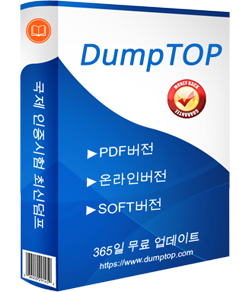IT 업계의 선두자로서 저희의 목표는 IT인증시험에 참가하는 모든 분들께 도움을 제공해드리는 것입니다. 이 목표를 달성하기 위해 저희의 전문가들은 시간이 지날수록 쌓이는 경험과 노하우로 IT자격증시험 응시자분들을 지원하고 있습니다.덤프제작팀의 엘리트들은 최선을 다하여 근년래 출제된 IBM watsonx Generative AI Engineer - Associate 시험문제의 출제경향을 분석하고 정리하여 가장 적중율 높은 C1000-185시험대비 자료를 제작하였습니다.이와 같은 피타는 노력으로 만들어진 C1000-185 덤프는 이미 많은 분들을 도와 C1000-185시험을 패스하여 자격증을 손에 넣게 해드립니다.
시험대비자료는 덤프가 최고
처음으로 자격증에 도전하시는 분들이 많을것이라 믿습니다.우선 시험센터나 인증사 사이트에서 고객님께서 취득하려는 자격증이 어느 시험을 보셔야 취득이 가능한지 확인하셔야 합니다.그리고 시험시간,출제범위,시험문항수와 같은 IBM watsonx Generative AI Engineer - Associate시험정보에 대해 잘 체크하신후 그 시험코드와 동일한 코드로 되어있는 덤프를 구매하셔서 시험공부를 하시면 됩니다.C1000-185덤프구매전 사이트에서 일부분 문제를 다운받아 덤프유효성을 확인하셔도 좋습니다.저희 사이트의 영원히 변치않는 취지는 될수있는 한 해드릴수 있는데까지 C1000-185시험 응시자 분들께 편리를 가져다 드리는것입니다. 응시자 여러분들이 시험을 우수한 성적으로 합격할수 있도록 적중율 높은 덤프를 제공해드릴것을 약속드립니다.
덤프유효기간을 최대한 연장
C1000-185덤프를 구매하시면 1년무료 업데이트 서비스를 제공해드립니다.덤프제작팀은 거의 매일 모든 덤프가 업데이트 가능한지 체크하고 있는데 업데이트되면 고객님께서 덤프구매시 사용한 메일주소에 따끈따끈한 가장 최신 업데이트된 C1000-185덤프자료를 발송해드립니다.고객님께서 구매하신 덤프의 유효기간을 최대한 연장해드리기 위해 최선을 다하고 있지만 혹시라도 IBM watsonx Generative AI Engineer - Associate시험문제가 변경되어 시험에서 불합격 받으시고 덤프비용을 환불받는다면 업데이트 서비스는 자동으로 종료됩니다.
자격증의 필요성
IT업계에 종사하시는 분께 있어서 국제인증 자격증이 없다는 것은 좀 심각한 일이 아닌가 싶습니다. 그만큼 자격증이 취직이거나 연봉협상, 승진, 이직 등에 큰 영향을 끼치고 있습니다. C1000-185시험을 패스하여 자격증을 취득하시면 고객님께 많은 이로운 점을 가져다 드릴수 있습니다. 이렇게 중요한 시험인만큼 고객님께서도 시험에 관해 검색하다 저희 사이트까지 찾아오게 되었을것입니다. C1000-185덤프를 공부하여 시험을 보는것은 고객님의 가장 현명한 선택이 될것입니다.덤프에 있는 문제를 마스터하시면 IBM watsonx Generative AI Engineer - Associate시험에서 합격할수 있습니다.구매전이거나 구매후 문제가 있으시면 온라인서비스나 메일상담으로 의문점을 보내주세요. 친절한 한국어 서비스로 고객님의 문의점을 풀어드립니다.
최신 IBM Certified watsonx Generative AI Engineer - Associate C1000-185 무료샘플문제:
1. You are reviewing the results of a prompt-tuning experiment where the goal was to improve an LLM's ability to summarize technical documentation. Upon inspecting the experiment results, you notice that the model has a high recall but relatively low precision.
What does this likely indicate about the model's performance, and how should you approach further tuning?
A) The model is generating too many irrelevant details; focus on improving precision.
B) The model is overly conservative, missing relevant details; focus on improving recall.
C) The model's length of generated summaries is too short, indicating underfitting.
D) The model's summaries are incomplete, indicating poor understanding of the source material; consider fine-tuning the pre-trained embeddings.
2. You are tasked with designing a LangChain-based AI workflow using watsonx.ai that incorporates multiple models for different tasks: document classification, entity extraction, and text generation. The final output should consist of a well-structured report that combines these processes.
What is the best strategy to orchestrate this workflow to ensure seamless integration of all tasks and a coherent final output?
A) Build a modular workflow where each task operates independently without passing data between them, ensuring each task can be validated separately before generating the final report.
B) Use document classification to filter the input data, followed by entity extraction to identify key terms, and then pass the refined information to watsonx.ai for text generation.
C) Start with text generation using watsonx.ai and then refine the output through document classification and entity extraction.
D) Run the document classification, entity extraction, and text generation tasks in parallel and merge the results at the end to produce the final report.
3. You are preparing a dataset for fine-tuning a model to classify customer complaints by category. The dataset is imbalanced, with 70% of the data representing complaints about billing, 20% representing complaints about technical issues, and 10% representing complaints about product quality.
Which of the following actions would help address the imbalance while preparing the dataset for fine-tuning? (Select two)
A) Add more synthetic data for the minority classes by using generative techniques like GPT-3 to create realistic complaints.
B) Leave the dataset as-is, trusting the model to handle the imbalance using its internal mechanisms.
C) Apply class weighting during model training instead of modifying the dataset itself.
D) Undersample the majority class (billing complaints) to balance the dataset.
E) Oversample the under-represented classes to ensure a balanced distribution across categories.
4. You are training a chatbot to handle customer inquiries for a telecommunications company. To augment your training data, you decide to generate synthetic data using IBM's InstructLab platform. You aim to improve the model's ability to handle rare or edge-case scenarios, such as technical issues with specific device models. You are following the LAB (Large-scale Alignment for chatBots) methodology to ensure alignment of the chatbot's responses with company policies.
Which of the following steps is most aligned with LAB methodology principles for generating synthetic data in this case?
A) Manually write every possible customer inquiry scenario to ensure quality
B) Generate synthetic customer inquiries and responses based on company policy guidelines
C) Generate synthetic data without aligning it with company policies to maximize diversity
D) Use random generation to create a diverse range of responses without constraints
5. You are working on generating synthetic training data using IBM InstructLab to supplement a small dataset for a question-answering system.
Which strategy would most effectively enhance the dataset without introducing biases or artifacts?
A) Generate a large amount of synthetic data by directly feeding the model with random prompts, ensuring data diversity.
B) Manually tweak each generated response to ensure it's free of errors and aligns with the intended task.
C) Automatically generate synthetic data using a different model architecture than the one being fine-tuned.
D) Use prompts that closely mimic the structure and semantics of the real dataset's questions to maintain consistency.
질문과 대답:
| 질문 # 1 정답: A | 질문 # 2 정답: B | 질문 # 3 정답: C,E | 질문 # 4 정답: B | 질문 # 5 정답: D |


 329 고객 리뷰
329 고객 리뷰





